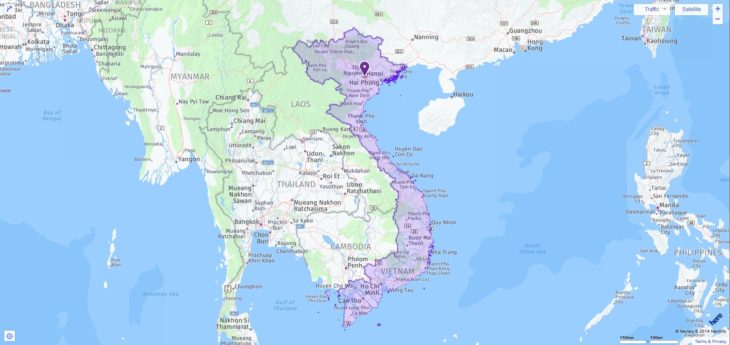Your search found 6 matches. The following is the full list of ACT testing locations in Viet Nam among which you can pick one to take the exam. Please know that on the test day, test takers can use any 4-function, scientific, or graphing calculator. On the table below, you can also find all test dates through 2019.

2019-2020 ACT Test Dates in Viet Nam
| Test Date | Registration Deadline |
| February 9, 2019 | January 11, 2019 |
| April 13, 2019 | March 8, 2019 |
| June 8, 2019 | May 3, 2019 |
| July 13, 2019 | June 14, 2019 |
| September 14, 2019 | August 16, 2019 |
| October 26, 2019 | September 20, 2019 |
| December 14, 2019 | November 8, 2019 |
| February 8, 2020 | January 10, 2020 |
| April 4, 2020 | February 28, 2020 |
| June 13, 2020 | May 8, 2020 |
| July 18, 2020 | June 19, 2020 |
ACT Test Centers in Viet Nam
| City | Center Name | Center Code |
| Danang City | Singapore Intl School At Da Nong | 873870 |
| Haiphong | Qsi International Sch Of Haiphong | 872670 |
| Hanoi | Singapore Intl School At Gamuda G | 874910 |
| Hanoi | St Paul American School Hanoi | 873530 |
| Ho Chi Minh City | APU International School | 872850 |
| Ho Chi Minh City | Singapore Intl Sch @ Saigon South | 873960 |
More about Vietnam
Geography
Vietnam stretches for around 1750 km from the southern Chinese mountains in the north to the Ca Mau peninsula in the south. At its narrowest point, the land is only 60 km wide. The approximately 3400 km long coast with Halong Bay in the north and popular beaches in the central part of the country is a magnet for tourists. The core area in the north is the wide, fertile and extremely densely populated lowland in the Red River delta. The lowlands are surrounded by mountains. The Fan Si Pan (3143 m above sea level) is the highest point in Vietnam. The central part of the country is predominantly occupied by the Annamite Cordillera, which stretches in parts to the coast of the South China Sea. The heartland in the south is the swampy Mekong Delta, which is crossed by numerous watercourses and used intensively for rice cultivation. The rivers are important transport routes; some sections of the river are used as “floating markets”.
The climate is subtropical in the north and tropical in the south. In the summer months, the southwest monsoon brings abundant rainfall. Typhoons frequently hit Vietnam during the southwest monsoon. The rise in sea levels due to climate change repeatedly leads to the penetration of salty seawater onto the rice fields, especially in the Mekong Delta. Mangrove forests were planted along the coast as protection.
The vegetation is determined in the south by tropical rainforests, in the north there are monsoon forests that shed their leaves during the dry season. Agent Orange, the defoliant used by the United States during the Vietnam War, destroyed large areas of forest. The species-rich fauna is in part severely threatened by the destruction of forest areas and illegal poaching. Rhinos, elephants and tigers are particularly at risk.
Politics and law
Vietnam is a socialist republic under the 1992 constitution. The people elect a parliament, the National Assembly, for five years. Parliament appoints a president from among its ranks as head of state and elects a prime minister as head of government. The Communist Party is the only admitted party in Vietnam. There are no opposition parties. It is forbidden to criticize the party or the government in public. Critics of the regime face several years’ imprisonment.
According to the constitution, the Communist Party of Vietnam is the leading force in society. The Central Committee is at the head of the Communist Party. It elects the 17 members of the Politburo with the Secretary General as chairman. In September 2018, Secretary General Nguyen Phu Trong (* 1944) was also elected President. This makes him the most powerful man in the country. Domestically, the freedoms are severely curtailed, in foreign and economic policy the government is pursuing a contradicting strategy. Here the country operates a policy of opening up. It is a member of the ASEAN confederation and the World Trade Organization (WTO). Vietnam has also let many foreign companies into the country.
The children must go to school for at least five years. No school fees are charged for attending this period of compulsory schooling. In rural areas in particular, many parents cannot afford to pay for school uniforms and learning materials. In addition, many children have to help on their parents’ farm. Some of them therefore drop out of school prematurely.
Following compulsory schooling, the children can attend secondary schools or vocational and technical schools for four or seven years. Vietnam is one of the countries where education plays a major role. Parents who can afford it spend a lot of money on tutoring their children. There are over 400 universities and colleges in Vietnam. However, very difficult entrance exams have to be passed before starting the course. Many Vietnamese aspire to study abroad at university.

